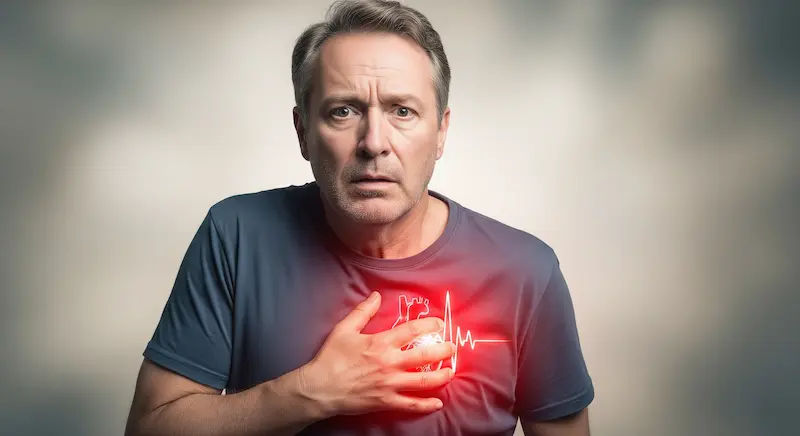Cor Pulmonale Disease: Causes, Signs, and Diagnosis
Cor pulmonale is a right-sided heart condition caused by chronic lung disease. Learn key causes, signs, diagnosis, and when to seek help. Understand tests, treatment priorities, and practical monitoring tips.

Written by Dr. Mohammed Kamran
Reviewed by Dr. Rohinipriyanka Pondugula MBBS
Last updated on 29th Oct, 2025

Introduction
This section explains what cor pulmonale is and why early identification matters.
If you or a loved one has chronic lung problems and new swelling of the ankles, breathlessness on mild exertion, or fainting spells, you might wonder if the lungs are straining the heart. Cor pulmonale is the medical term for right-sided heart changes caused by lung disease, most often due to long-standing low oxygen levels and high pressure in the blood vessels of the lungs. While the term sounds technical, recognising early signs and getting the right tests can prevent complications and improve quality of life. In this guide, we break down what cor pulmonale disease is, who is at risk, the most telling symptoms, and how doctors confirm the diagnosis. You will also learn which tests are commonly used (from ECGs to echocardiograms and right heart catheterisation), what to track at home, and how to talk with your care team. Consult a Top Pulmonologist for Personalised Advice
What Is Cor Pulmonale?
Definition and why it differs from other right-heart issues. Cor pulmonale refers to changes in the structure and performance of the right ventricle—the heart chamber that pumps blood into the lungs—due to lung disease and a resulting rise in pulmonary artery pressure. In simple terms, diseased lungs make the right side of the heart work too hard. Over time, the heart muscle thickens, stretches, and may weaken.
Cor pulmonale vs general right-sided heart failure
• Right-sided heart failure describes fluid retention, leg swelling, and liver congestion no matter the cause.
• Cor pulmonale is specifically a right-heart failure pattern due to lung disease or pulmonary vascular pathology, not from left-heart disease.
Treatments differ: managing lung disease and oxygen levels is central in cor pulmonale.
Acute vs chronic cor pulmonale
• Acute: sudden onset, usually from a large pulmonary embolism, causing collapse or severe breathlessness.
• Chronic: gradual onset in COPD, interstitial lung disease or sleep-disordered breathing.
How Cor Pulmonale Develops: The Pathophysiology
Overview of the strain created by poor lung function.
Lung disease reduces oxygen levels in the air sacs. Blood vessels constrict in low-oxygen regions (hypoxic pulmonary vasoconstriction), which continually raises pulmonary artery pressure. Persistent low oxygen also changes vessel structure—thickening the walls and making them stiffer.
Right ventricle adaptation
Initially, the right ventricle thickens to maintain pumping ability. With continued strain, it dilates, becomes less efficient, and can stretch the tricuspid valve, worsening fluid retention.
Lung mechanics
Conditions like COPD (air trapping), pulmonary fibrosis (stiff lungs), and chest-wall restriction all increase resistance to blood flow. Sleep apnoea adds repeated night-time hypoxia. The shared endpoint is pulmonary hypertension, the key bridge between lung disease and cor pulmonale.
Who Is at Risk? Causes and Risk Factors
Common chronic and acute drivers of the condition.
Chronic obstructive pulmonary disease (COPD) is the leading global cause. Frequent flare-ups, decreased oxygen levels, and long-term vascular changes raise pulmonary pressures.
Other causes
• Interstitial lung diseases: stiffen lungs and impair oxygen exchange.
• Obstructive sleep apnoea and obesity-hypoventilation: elevated pressures, particularly overnight.
• Chest-wall/spinal conditions: restrict breathing (e.g., severe kyphoscoliosis).
• Long-term high-altitude exposure raises pulmonary pressures in susceptible people.
Acute trigger
A pulmonary embolism can suddenly overload the right ventricle and is a medical emergency.
Modifiable risks
Smoking, biomass fuel exposure, and occupational dust/fume inhalation significantly increase risk—especially in low- and middle-income settings.
Early Warning Signs and Symptoms You Should Not Ignore
How to identify worsening right-heart strain early.
Symptoms progress gradually but should not be dismissed.
Breathing-related symptoms
• Breathlessness on exertion, later even at rest
• Chronic cough and wheeze
Right-heart strain signs
• Ankle and leg swelling
• Abdominal bloating/fullness
• Prominent neck veins
• Fatigue and reduced tolerance for normal activity
Red flags
• Chest pain
• Fainting (especially with effort)
• Sudden severe breathlessness — could indicate pulmonary embolism
If symptoms persist beyond two weeks, consult a doctor online with Apollo 24|7. Urgent symptoms require emergency care.
How Doctors Diagnose Cor Pulmonale (Step-by-Step)
This section outlines the clinical evaluation and key investigations. Diagnosis combines examination with targeted tests.
Clinical examination clues
• Loud pulmonary component of the second heart sound (P2)
• Right ventricular heave
• Leg swelling, liver enlargement
• Bluish lips/fingers from low oxygen
Initial tests
• Pulse oximetry: quick screening for low oxygen
• Arterial blood gas (ABG): assesses true oxygen and carbon dioxide levels
• CBC/metabolic tests: may show increased red blood cells due to low oxygen
Apollo 24|7 offers home collection for most basic blood tests; ABG typically requires a clinical setting.
Imaging
• Chest X-ray: enlarged pulmonary arteries, right-heart enlargement, underlying lung disease
• CT chest: details lung structure; CT angiography if pulmonary embolism is suspected
• V/Q scan: useful for detecting chronic thromboembolic pulmonary hypertension (CTEPH)
ECG changes
Right-axis deviation, right atrial enlargement and right bundle branch block may indicate right-ventricular strain.
Echocardiography
Assesses pulmonary pressures, right-ventricular size and function, and helps rule out left-heart causes.
Pulmonary function tests
Identify obstructive (COPD) or restrictive (fibrosis) patterns and impaired gas transfer.
Right heart catheterisation
The gold standard for confirming pulmonary hypertension and differentiating causes when uncertainty remains.
Case Study: From Breathlessness to Diagnosis
A real-world link between symptoms and testing.
Mr K, a 62-year-old ex-smoker with COPD, reports worsening breathlessness and ankle swelling. Oxygen saturation is 88–90% at rest. Examination shows raised neck veins and ankle oedema. Tests confirm severe obstruction, raised pulmonary artery pressure and right-ventricular dilation. He begins pulmonary rehabilitation, optimised inhaler therapy and qualifies for long-term oxygen therapy. His swelling reduces with careful diuretic use. This structured approach is typical and highlights the benefit of early action.
When to Seek Medical Help—and What to Ask
How to prioritise safety and prepare for consultations.
Urgent warning signs: sudden severe breathlessness, chest pain, fainting, rapidly worsening swelling.
If symptoms persist beyond two weeks, consult a doctor online with Apollo 24|7. If symptoms worsen, book an in-person evaluation promptly.
Preparing for your appointment
Bring:
• A timeline of symptoms
• Home pulse oximeter readings
• Daily weight log
• Latest medical reports
Questions to ask:
• Do I need an echocardiogram?
• Should I be checked for sleep apnoea?
• Am I eligible for long-term oxygen therapy?
At-Home Measures While You Seek Care
Steps that support your lungs and heart day-to-day.
Stopping smoking is the most crucial intervention.
Lung protection and oxygen safety
• Avoid fumes and indoor smoke
• If prescribed oxygen, use safely and consistently
Self-monitoring
• Track oxygen saturation trends
• Watch for fluid build-up via daily weight
• Keep a symptom diary
Vaccinations and diet
• Annual influenza and routine pneumococcal vaccines
• Moderate salt intake to limit fluid retention
Preventing Cor Pulmonale or Slowing Its Progression
Focus on treating underlying lung disease and hypoxia. Pulmonary rehabilitation and correct inhaler use are key.
COPD management
• Proper inhaler technique
• Rehabilitation to improve exercise tolerance
• Long-term oxygen therapy when needed
Sleep apnoea and weight management
CPAP improves night-time oxygenation; weight loss reduces breathing workload.
Air quality and altitude
Avoid polluted environments; discuss oxygen needs before high-altitude travel.
Common Myths and Misconceptions
Clarifying frequent misunderstandings.
• Pulmonary hypertension does not always originate from left-heart disease
• A normal ECG does not exclude cor pulmonale
• Oxygen therapy is not addictive
Tests You May Hear About: What They Mean
Extra tests are used in specific scenarios.
• D-dimer and CT pulmonary angiography identify acute pulmonary embolism
• Six-minute walk test monitors functional capacity and oxygen drop with exercise
Outlook and Possible Complications
What shapes prognosis and how to reduce flare-ups.
Better outcomes occur with smoking cessation, good inhaler adherence, rehabilitation, and oxygen when prescribed.
Complications
• Atrial arrhythmias
• Fainting due to high pulmonary pressures
• Fluid overload affecting the kidneys and breathing
Daily weight monitoring can catch early fluid retention and prevent hospitalisation.
Conclusion
Cor pulmonale is a consequence of strained lungs affecting the right side of the heart. Recognising and addressing early signs—breathlessness, swelling, low oxygen—can prevent severe complications. Diagnosis is built step-by-step: examination, blood tests, imaging, ECG, echocardiography and pulmonary function tests. In selected cases, right heart catheterisation guides management. The most effective way to change the trajectory is to treat the underlying lung disease: stop smoking, use inhalers correctly, complete pulmonary rehabilitation, treat sleep apnoea and use oxygen therapy when indicated. Be proactive: track your symptoms and partner closely with your care team. If concerned, consult a doctor online with Apollo 24|7; if your condition worsens, arrange a physical visit promptly. Consult a Top Pulmonologist for Personalised Advice
Consult a Top Pulmonologist for Personalised Advice
Dr. Naseeha Mohammed S V
Pulmonology Respiratory Medicine Specialist
6 Years • MBBS, MD ,DNB Respiratory Medicine
Bengaluru
Apollo Clinic, Sarjapur Road, Bengaluru

Dr Rakesh Bilagi
Pulmonology Respiratory Medicine Specialist
10 Years • MBBS MD PULMONOLOGIST
Bengaluru
Apollo Clinic, JP nagar, Bengaluru

Dr. Gomathi R G
Respiratory Medicine/ Covid Consult
7 Years • MBBS, MD (TB & Pul. Med.)
Chennai
Apollo First Med Hospitals P H Road, Chennai

Dr. Asif Iqbal. Respiratory Medicine Specialists.
Pulmonology Respiratory Medicine Specialist
14 Years • DNB (Anesthesia), FCCP (USA), Respiratory Medicine Specialist, IDCCCM (Critical Care Medicine), MBBS
Kolkata
Apollo Multispeciality Hospitals , Kolkata, Kolkata
(25+ Patients)

Dr. Sumara Maqbool
Pulmonology Respiratory Medicine Specialist
12 Years • MBBS, DNB Respiratory, critical care and sleep medicine, DrNB superspeciality Critical care, IDCCM, IFCCM, EDIC
Delhi
Apollo Hospitals Indraprastha, Delhi
(25+ Patients)
Consult a Top Pulmonologist for Personalised Advice
Dr. Naseeha Mohammed S V
Pulmonology Respiratory Medicine Specialist
6 Years • MBBS, MD ,DNB Respiratory Medicine
Bengaluru
Apollo Clinic, Sarjapur Road, Bengaluru

Dr Rakesh Bilagi
Pulmonology Respiratory Medicine Specialist
10 Years • MBBS MD PULMONOLOGIST
Bengaluru
Apollo Clinic, JP nagar, Bengaluru

Dr. Gomathi R G
Respiratory Medicine/ Covid Consult
7 Years • MBBS, MD (TB & Pul. Med.)
Chennai
Apollo First Med Hospitals P H Road, Chennai

Dr. Asif Iqbal. Respiratory Medicine Specialists.
Pulmonology Respiratory Medicine Specialist
14 Years • DNB (Anesthesia), FCCP (USA), Respiratory Medicine Specialist, IDCCCM (Critical Care Medicine), MBBS
Kolkata
Apollo Multispeciality Hospitals , Kolkata, Kolkata
(25+ Patients)

Dr. Sumara Maqbool
Pulmonology Respiratory Medicine Specialist
12 Years • MBBS, DNB Respiratory, critical care and sleep medicine, DrNB superspeciality Critical care, IDCCM, IFCCM, EDIC
Delhi
Apollo Hospitals Indraprastha, Delhi
(25+ Patients)
More articles from General Medical Consultation
Frequently Asked Questions
1) Is cor pulmonale the same as pulmonary hypertension?
No. Pulmonary hypertension describes high pressure in the lungs’ blood vessels. Cor pulmonale is right-heart enlargement/failure due to lung disease and pulmonary hypertension.
2) What are classic ECG changes in cor pulmonale?
Right-axis deviation, right atrial enlargement, R/S ratio >1 in V1 and right bundle branch block—though findings vary.
3) When is right heart catheterisation needed?
When non-invasive tests are inconclusive or when distinguishing lung-related causes from left-heart causes is crucial.
4) Can sleep apnoea cause cor pulmonale?
Yes. Untreated obstructive sleep apnoea can raise pulmonary pressures. CPAP can reduce this strain.
5) Which lifestyle changes help most?
Quit smoking, adhere to inhalers, pulmonary rehabilitation, treat sleep apnoea, vaccinations, and oxygen therapy if you meet criteria. Monitor oxygen levels and weight.
 Benefits, Precautions, and How to Do It.webp)



